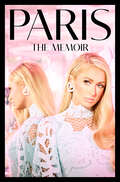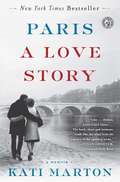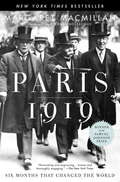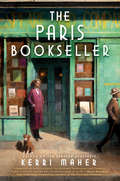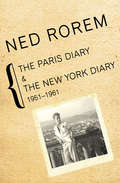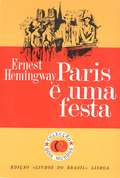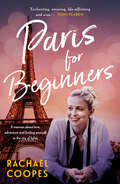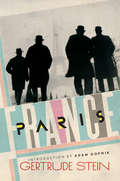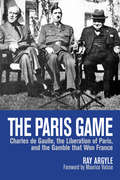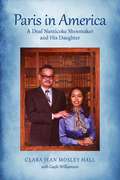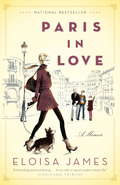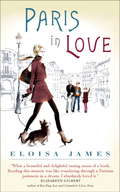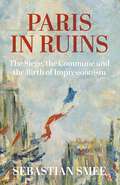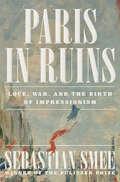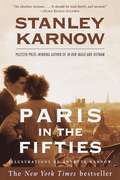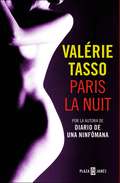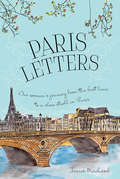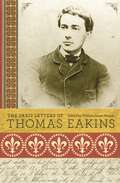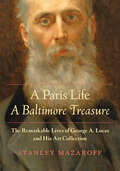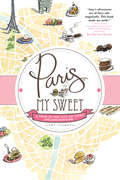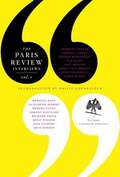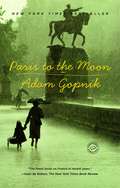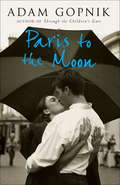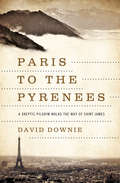- Table View
- List View
Paris: The Memoir
by Paris Hilton***An Instant New York Times Bestseller***From the woman who is credited for launching what we know as the celebrity focused, “brand” driven, social media obsessed popular culture of today, comes an honest and surprising memoir that reckons with that truth, and shows that there is so much more to Paris Hilton than you might believe.I was born in New York City on February 17, 1981, three days after Valentine’s Day. From the time I was a toddler, my brain skipped and flickered with the chemical imbalance of ADHD. Sometimes it was too much.I’m not bragging or complaining about it, just telling you: This is my brain. It has a lot to do with how this whole book thing is going to play out, because I love run-on sentences—and dashes. And sentence fragments. I’m probably going to jump around a lot while I tell the story.I came of age during the most turbulent pop culture period ever.The character I played—part Lucy, part Marilyn—was my steel-plated armor.People loved her. Or they loved to hate her, which was just as marketable. I leaned into that character, my ticket to financial freedom and a safe place to hide. I made sure I never had a quiet moment to figure out who I was without her. I was afraid of that moment because I didn’t know what I’d find.I wrote this book in an effort to understand my place in a watershed moment: the technology renaissance, the age of influencers. I also wrote this book so that the world could know who I am today. I focused on key aspects of my life that led to what I am most proud of--how my power was taken away from me and how I took it back, how I built a thriving business, a marriage and a family.There are so many young women who need to hear this story. I don’t want them to learn from my mistakes; I want them to stop hating themselves for their own mistakes. I want them to laugh and cry and embrace every aspect of who they are with fearlessness and pride. We all have our own brand of intelligence, and, girl, fuck fitting in.
Paris: A Love Story
by Kati MartonThis is a memoir for anyone who has ever fallen in love in Paris, or with Paris. Paris: A Love Story is for anyone who has ever had their heart broken or their life upended. In this remarkably honest and candid memoir, award-winning journalist and distinguished author Kati Marton narrates an impassioned and romantic story of love, loss, and life after loss. Paris is at the heart of this deeply moving account. At every stage of her life, Marton finds beauty and excitement in Paris, and now, after the sudden death of her husband, Richard Holbrooke, the city offers a chance for a fresh beginning. With intimate and nuanced portraits of Peter Jennings, the man to whom she was married for fifteen years and with whom she had two children, and Holbrooke, with whom she found enduring love, Marton paints a vivid account of an adventuresome life in the stream of history. Inspirational and deeply human, Paris: A Love Story will touch every generation.
Paris 1919: Six Months That Changed the World (Coleção Nova Fronteira Ser.)
by Margaret MacmillanWinner of the Samuel Johnson Prize Winner of the PEN Hessell Tiltman Prize Winner of the Duff Cooper Prize Between January and July 1919, after "the war to end all wars," men and women from around the world converged on Paris to shape the peace. Center stage, for the first time in history, was an American president, Woodrow Wilson, who with his Fourteen Points seemed to promise to so many people the fulfillment of their dreams. Stern, intransigent, impatient when it came to security concerns and wildly idealistic in his dream of a League of Nations that would resolve all future conflict peacefully, Wilson is only one of the larger-than-life characters who fill the pages of this extraordinary book. David Lloyd George, the gregarious and wily British prime minister, brought Winston Churchill and John Maynard Keynes. Lawrence of Arabia joined the Arab delegation. Ho Chi Minh, a kitchen assistant at the Ritz, submitted a petition for an independent Vietnam. For six months, Paris was effectively the center of the world as the peacemakers carved up bankrupt empires and created new countries. This book brings to life the personalities, ideals, and prejudices of the men who shaped the settlement. They pushed Russia to the sidelines, alienated China, and dismissed the Arabs. They struggled with the problems of Kosovo, of the Kurds, and of a homeland for the Jews. The peacemakers, so it has been said, failed dismally; above all they failed to prevent another war. Margaret MacMillan argues that they have unfairly been made the scapegoats for the mistakes of those who came later. She refutes received ideas about the path from Versailles to World War II and debunks the widely accepted notion that reparations imposed on the Germans were in large part responsible for the Second World War. A landmark work of narrative history,Paris 1919is the first full-scale treatment of the Peace Conference in more than twenty-five years. It offers a scintillating view of those dramatic and fateful days when much of the modern world was sketched out, when countries were created--Iraq, Yugoslavia, Israel--whose troubles haunt us still. From the Hardcover edition.
The Paris Bookseller
by Kerri MaherOne of SheReads&’ Best Literary Historical Fiction Coming in 2022 One of Reader&’s Digest&’s Best Books for Women Written by Female Authors The dramatic story of how a humble bookseller fought against incredible odds to bring one of the most important books of the 20th century to the world in this new novel from the author of The Girl in White Gloves. When bookish young American Sylvia Beach opens Shakespeare and Company on a quiet street in Paris in 1919, she has no idea that she and her new bookstore will change the course of literature itself. Shakespeare and Company is more than a bookstore and lending library: Many of the prominent writers of the Lost Generation, like Ernest Hemingway, consider it a second home. It's where some of the most important literary friendships of the twentieth century are forged—none more so than the one between Irish writer James Joyce and Sylvia herself. When Joyce's controversial novel Ulysses is banned, Beach takes a massive risk and publishes it under the auspices of Shakespeare and Company. But the success and notoriety of publishing the most infamous and influential book of the century comes with steep costs. The future of her beloved store itself is threatened when Ulysses' success brings other publishers to woo Joyce away. Her most cherished relationships are put to the test as Paris is plunged deeper into the Depression and many expatriate friends return to America. As she faces painful personal and financial crises, Sylvia—a woman who has made it her mission to honor the life-changing impact of books—must decide what Shakespeare and Company truly means to her.
The Paris Diary & The New York Diary, 1951–1961: 1951-1961
by Ned RoremIn the earliest published diaries of Ned Rorem, the acclaimed American composer recalls a bygone era and its luminaries, celebrates the creative process, and examines the gay culture of Europe and the US during the 1950sOne of America&’s most significant contemporary composers, Ned Rorem is also widely acclaimed as a diarist of unique insight and refreshing candor. Together, his Paris Diary, first published in 1966, and The New York Diary,which followed a year later, paint a colorful landscape of Rorem&’s world and its famous inhabitants, as well as a fascinating self-portrait of a footloose young artist unabashedly drinking deeply of life. In this amalgam of forthright personal reflections and cogent social commentary, unprecedented for its time, Rorem&’s anecdotal recollections of the decade from 1951 to 1961 represent Gay Liberation in its infancy as the author freely expresses his open sexuality not as a revelation but as a simple fact of life. At once blisteringly honest and exquisitely entertaining, Rorem&’s diaries expound brilliantly on the creative process, following their peripatetic author from Paris to Morocco to Italy and back home to America as he crosses paths with Picasso, Cocteau, Gide, Boulez, and other luminaries of the era. With consummate skill and unexpurgated insight, a younger, wilder Rorem reflects on a bygone time and culture and, in doing so, holds a revealing mirror to himself.
Paris for Beginners: A memoir about love, adventure and finding yourself in the city of lights
by Rachael CoopesEnchanting, amusing, life-affirming and wise.' Toni PearenSometimes the best compass to follow is your heart.Actress Rachael Coopes had a serious boyfriend and successful career in Australia when she was awarded a scholarship to study at a renowned clown school in Paris.It was the opportunity of a lifetime, so she upped sticks and fully surrendered herself to the possibilities of Paris. Cue a coveted pied-à-terre with a view of the Eiffel Tower, quaffing champagne at midnight with her glamorous new amies, and learning how to flirt in French. But for all its charm and sensual pleasures, Paris had a hard lesson or two to teach her about life, and love.Paris for Beginners is about growing up (even when you're already, supposedly, a fully-fledged adult) and figuring out what you need in life, set against the perennially alluring backdrop of the City of Lights.
Paris France
by Gertrude Stein Adam GopnikMatched only by Hemingway's A Moveable Feast, Paris France is a "fresh and sagacious" (The New Yorker) classic of prewar France and its unforgettable literary eminences. Celebrated for her innovative literary bravura, Gertrude Stein (1874-1946) settled into a bustling Paris at the turn of the twentieth century, never again to return to her native America. While in Paris, she not only surrounded herself with--and tirelessly championed the careers of--a remarkable group of young expatriate artists but also solidified herself as "one of the most controversial figures of American letters" (New York Times). In Paris France (1940)--published here with a new introduction from Adam Gopnik--Stein unites her childhood memories of Paris with her observations about everything from art and war to love and cooking. The result is an unforgettable glimpse into a bygone era, one on the brink of revolutionary change.
The Paris Game: Charles de Gaulle, the Liberation of Paris, and the Gamble that Won France
by Ray Argyle Maurice VaïsseAt a crucial moment in the Second World War, an obscure French general reaches a fateful personal decision: to fight on alone after his government’s flight from Paris and its capitulation to Nazi Germany. Amid the ravages of a world war, three men — a general, a president, and a prime minister — are locked in a rivalry that threatens their partnership and puts the world’s most celebrated city at risk of destruction before it can be liberated. This is the setting of The Paris Game, a dramatic recounting of how an obscure French general under sentence of death by his government launches on the most enormous gamble of his life: to fight on alone after his country’s capitulation to Nazi Germany. In a game of intrigue and double-dealing, Charles de Gaulle must struggle to retain the loyalty of Winston Churchill against the unforgiving opposition of Franklin Roosevelt and the traitorous manoeuvring of a collaborationist Vichy France. How he succeeds in restoring the honour of France and securing its place as a world power is the stuff of raw history, both stirring and engrossing.
Paris in America: A Deaf Nanticoke Shoemaker and His Daughter
by Clara Jean Hall Gayle WilliamsonClara Jean Mosley Hall has inhabited various cultural worlds in her life: Native American, African American, Deaf, and hearing. The hearing daughter of a Deaf Nanticoke Indian, who grew up in Dover, Delaware’s black community in the 1950s and 60s, Hall describes the intersections of these identities in Paris in America. By sharing her father’s experiences and relating her own struggles and successes, Hall honors her father’s legacy of hard work and perseverance and reveals the complexities of her own unique background. Hall was abandoned by her Deaf African-American mother at a young age and forged a close bond with her father, James Paris Mosley, who communicated with her in American Sign Language. Although his family was American Indian, they—like many other Nanticoke Indians of that region—had assimilated over time into Dover’s black community. Hall vividly recounts the social and cultural elements that shaped her, from Jim Crow to the forced integration of public schools, to JFK and Motown. As a CODA (Child of Deaf Adults) in a time when no accessibility or interpreting services were available, she was her father’s sole means of communication with the hearing world, a heavy responsibility for a child. After her turbulent teenage years, and with the encouragement of her future husband, she attended college and discovered that her skills as a fluent ASL user were a valuable asset in the field of education. Hall went on to become a college professor, mentor, philanthropist, and advocate for Deaf students from diverse backgrounds. Her memoir is a celebration of her family, her faith, her journey, and her heritage.
Paris in Love: A Memoir
by Eloisa James<P>In 2009, New York Times bestselling author Eloisa James took a leap that many people dream about: she sold her house, took a sabbatical from her job as a Shakespeare professor, and moved her family to Paris. <P>Paris in Love: A Memoir chronicles her joyful year in one of the most beautiful cities in the world. With no classes to teach, no committee meetings to attend, no lawn to mow or cars to park, Eloisa revels in the ordinary pleasures of life--discovering corner museums that tourists overlook, chronicling Frenchwomen's sartorial triumphs, walking from one end of Paris to another. <P>She copes with her Italian husband's notions of quality time; her two hilarious children, ages eleven and fifteen, as they navigate schools--not to mention puberty--in a foreign language; and her mother-in-law Marina's raised eyebrow in the kitchen (even as Marina overfeeds Milo, the family dog). <P>Paris in Love invites the reader into the life of a most enchanting family, framed by la ville de l'amour. <P><b>A New York Times Bestseller</b>
Paris in Love: A Memoir
by Eloisa JamesA New York Times Bestseller. After years of living vicariously through the heroines in her novels, bestselling author Eloisa James takes a leap that most of us can only daydream about. She sells her house, leaves her job as a Shakespeare professor, and packs her husband and two protesting children off to Paris. Grand plans are abandoned as she falls under the spell of daily life as a Parisienne exquisite food, long walks by the Seine, reading in bed, displays of effortless chic around every corner, and being reminded of what really matters in a place where people seem to kiss all the time. Against one of the world s most picturesque backdrops, she copes with her Italian husband s notions of quality time; her two hilarious children, ages eleven and fifteen, as they navigate schools not to mention puberty in a foreign language; and her formidable mother-in-law, Marina, who believes dogs should be fed prosciutto and wives should live in the kitchen. An irresistible love letter to a city that will make you want to head there, Paris in Love is also a joyful testament to the pleasures of savouring life.
Paris in Ruins: The Siege, the Commune and the Birth of Impressionism
by Sebastian SmeePulitzer-winner Sebastian Smee relives the remarkable birth of Impressionism from the ashes of war Paris, January 1871 – the final, agonising days of the Franco-Prussian War. As the German army cements its advantage, shells rattle through the Left Bank. It is a bitterly cold winter; there is no fuel, no medicine, no food. The city&’s poorer citizens have long turned to eating rats, cats and dogs. France has been brought to its knees. Édouard Manet, Berthe Morisot, and Edgar Degas are trapped in the besieged city. Renoir and Bazille have joined regiments outside of Paris, while Monet and Pissarro fled the country just in time. Out of the Siege and the Commune, these artists developed a newfound sense of the fragility of life. A feeling for transience – reflected in Impressionism&’s emphasis on fugitive light, shifting seasons, glimpsed street scenes, and the impermanence of all things – would change art history forever. This is the extraordinary account of the &‘Terrible Year&’ in Paris and its monumental impact on the rise of Impressionism.
Paris in Ruins: Love, War, and the Birth of Impressionism
by Sebastian SmeeA Boston Globe “20 Books We Can’t Wait to Read This Fall” A Next Big Idea Club “Must-Read Book for September 2024” The Pulitzer Prize–winning art critic’s gripping account of the “Terrible Year” in Paris and its monumental impact on the rise of Impressionism. From the summer of 1870 to the spring of 1871, famously dubbed the “Terrible Year” by Victor Hugo, Paris and its people were besieged, starved, and forced into surrender by Germans—then imperiled again as radical republicans established a breakaway Commune, ultimately crushed by the French Army after bloody street battles and the burning of central Paris. As renowned art critic Sebastian Smee shows, it was against the backdrop of these tumultuous times that the Impressionist movement was born—in response to violence, civil war, and political intrigue. In stirring and exceptionally vivid prose, Smee tells the story of those dramatic days through the eyes of great figures of Impressionism. Édouard Manet, Berthe Morisot, and Edgar Degas were trapped in Paris during the siege and deeply enmeshed in its politics. Others, including Pierre-August Renoir and Frédéric Bazille, joined regiments outside of the capital, while Claude Monet and Camille Pissarro fled the country just in time. In the aftermath, these artists developed a newfound sense of the fragility of life. That feeling for transience—reflected in Impressionism’s emphasis on fugitive light, shifting seasons, glimpsed street scenes, and the impermanence of all things—became the movement’s great contribution to the history of art. At the heart of it all is a love story; that of Manet, by all accounts the father of Impressionism, and Morisot, the only woman to play a central role in the movement from the start. Smee poignantly depicts their complex relationship, their tangled effect on each other, and their great legacy, while bringing overdue attention to the woman at the heart of Impressionism. Incisive and absorbing, Paris in Ruins captures the shifting passions and politics of the art world, revealing how the pressures of the siege and the chaos of the Commune had a profound impact on modern art, and how artistic genius can emerge from darkness and catastrophe.
Paris in the Fifties
by Stanley KarnowIn July 1947, fresh out of college and long before he would win the Pulitzer Prize and become known as one of America's finest historians, Stanley Karnow boarded a freighter bound for France, planning to stay for the summer. He stayed for ten years, first as a student and later as a correspondent for Time magazine. By the time he left, Karnow knew Paris so intimately that his French colleagues dubbed him "le plus parisien des Américains" --the most Parisian American. Now, Karnow returns to the France of his youth, perceptively and wittily illuminating a time and place like none other. Karnow came to France at a time when the French were striving to return to the life they had enjoyed before the devastation of World War II. Yet even during food shortages, political upheavals, and the struggle to come to terms with a world in which France was no longer the mighty power it had been, Paris remained a city of style, passion, and romance. Paris in the Fifties transports us to Latin Quarter cafés and basement jazz clubs, to unheated apartments and glorious ballrooms. We meet such prominent political figures as Charles de Gaulle and Pierre Mendès-France, as well as Communist hacks and the demagogic tax rebel Pierre Poujade. We get to know illustrious intellectuals, among them Jean-Paul Sartre, Simone de Beauvoir, Albert Camus, and André Malraux, and visit the glittering salons where aristocrats with exquisite manners mingled with trendy novelists, poets, critics, artists, composers, playwrights, and actors. We meet Christian Dior, who taught Karnow the secrets of haute couture, and Prince Curnonsky, France's leading gourmet, who taught the young reporter to appreciate the complexities of haute cuisine. Karnow takes us to marathon murder trials in musty courtrooms, accompanies a group of tipsy wine connoisseurs on a tour of the Beaujolais vineyards, and recalls the famous automobile race at Le Mans when a catastrophic accident killed more than eighty spectators. Back in Paris, Karnow hung out with visiting celebrities like Ernest Hemingway, Orson Welles, and Audrey Hepburn, and in Paris in the Fifties we meet them too.A veteran reporter and historian, Karnow has written a vivid and delightful history of a charmed decade in the greatest city in the world.From the Trade Paperback edition.
Paris la nuit
by Valérie TassoEn Paris la nuit la autora se plantea una redefinición total de los sexos. Un libro atrevido que sorprende y hechiza, un relato autobiográfico que se lee como una novela y donde nada es lo que parece. Pero que desvela la intimidad de una mujer valiente, sus miedos y sus deseos. Para mejorar sus conocimientos de lengua japonesa, Valérie Tasso decide inscribirse en el Instituto de Lenguas Orientales de París. Se aloja en casa de su amiga Mimi, una lesbiana que esconde más de un secreto, y a los pocos días conoce a Pipo, un enigmático taxista que le descubre los rincones ocultos del París más prohibido, el que no aparece en las guías turísticas. Convertida en una cronista -o en una voyeur-, Valérie cuenta todo lo que vio y sintió durante aquel caluroso verano parisino en el que vivió intensamente noches de pasión y deseo: orgías sadomasoquistas, escenas con prostitutasy travestis, un reencuentro sexual en un cóctel de la alta sociedad... Todo ello le obligará a replantearse su identidad sexual y le provocará una perplejidad que irá creciendo a lo largo del libro: ¿qué misterio esconde Pipo? Si en Diario de una ninfómana relataba sin tapujos sus experiencias sexuales, en Paris la nuit la autora se plantea una redefinición total de los sexos: sugiere que no hay homosexuales o heterosexuales sino personas, y todas ellas son, en última instancia, bisexuales. Reseña:«Episodios no aptos para mentes puritanas.»Cosmopolitan
Paris Letters
by Janice MacleodFinding love and freedom in a pen, a paintbrush...and Paris How much money does it take to quit your job? Exhausted and on the verge of burnout, Janice poses this questions to herself as she doodles on a notepad at her desk. Surprisingly, the answer isn't as daunting as she expected. With a little math and a lot of determination, Janice cuts back, saves up, and buys herself two years of freedom in Europe. A few days into her stop in Paris, Janice meets Christophe, the cute butcher down the street--who doesn't speak English. Through a combination of sign language and franglais, they embark on a whirlwind Paris romance. She soon realizes that she can never return to the world of twelve-hour workdays and greasy corporate lingo. But her dwindling savings force her to find a way to fund her dreams again. So Janice turns to her three loves--words, art, and Christophe--to figure out a way to make her happily-ever-after in Paris last forever.
The Paris Letters of Thomas Eakins
by Thomas EakinsThe young Thomas Eakins's most revealing letters—published here for the first timeThe most revealing and interesting writings of American artist Thomas Eakins are the letters he sent to family and friends while he was a student in Paris between 1866 and 1870. This book presents all these letters in their entirety for the first time; in fact, this is the first edition of Eakins's correspondence from the period. Edited and annotated by Eakins authority William Innes Homer, this book provides a treasure trove of new information, revealing previously hidden facets of Eakins's personality, providing a much richer picture of his artistic development, and casting fresh light on his debated psychosexual makeup. The book is illustrated with the small, gemlike drawings Eakins included in his correspondence, as well as photographs and paintings.In these letters, Eakins speaks openly and frankly about human relationships, male companionship, marriage, and women. In vivid, charming, and sometimes comic detail, he describes his impressions of Paris--from the training he received in the studio of Jean-Léon Gérôme to the museums, concerts, and popular entertainments that captured his imagination. And he discusses with great insight contemporary aesthetic and scientific theories, as well as such unexpected subjects as language structure, musical composition, and ice-skating technique. Also published here for the first time are the letters and notebook Eakins wrote in Spain following his Paris sojourn.This long-overdue volume provides an indispensable portrait of a great American artist as a young man.
A Paris Life, A Baltimore Treasure: The Remarkable Lives of George A. Lucas and His Art Collection
by Stanley MazaroffThe gripping biography of a man and his passion for art.In 1857, George A. Lucas, a young Baltimorean who was fluent in French and enamored of French art, arrived in Paris. There, he established an extensive personal network of celebrated artists and art dealers, becoming the quintessential French connection for American collectors. The most remarkable thing about Lucas was not the art that he acquired for his clients (who included William and Henry Walters, the founders of the Walters Art Museum, and John Taylor Johnston, the founding president of the Metropolitan Museum of Art) but the massive collection of 18,000 paintings, drawings, sculptures, and etchings, as well as 1,500 books, journals, and other sources about French artists, that he acquired for himself. Paintings by Cabanel, Corot, and Daubigny, prints by Whistler, Manet, and Cassatt, and portfolios of information about hundreds of French artists filled his apartment and spilled into the adjacent flat of his mistress.Based primarily on Lucas’s notes and diaries, as well as thousands of other archival documents, Stanley Mazaroff’s A Paris Life, A Baltimore Treasure tells the fascinating story of how Lucas brought together the most celebrated French artists with the most prominent and wealthy American collectors of the time. It also details how, nearing the end of his life, Lucas struggled to find a future home for his collection, eventually giving it to Baltimore’s Maryland Institute. Without the means to care for the collection, the Institute loaned it to the Baltimore Museum of Art, where most of the art was placed in storage and disappeared from public view. But in 1990, when the Institute proposed to auction or otherwise sell the collection, it rose from obscurity, reached new glory as an irreplaceable cultural treasure, and became the subject of an epic battle fought in and out of court that captivated public attention and enflamed the passions of art lovers and museum officials across the nation.A Paris Life, A Baltimore Treasure is a richly illustrated portrayal of Lucas's fascinating life as an agent, connoisseur, and collector of French mid-nineteenth-century art. And, as revealed in the book, following Lucas's death, his enormous collection continued to have a vibrant life of its own, presenting new challenges to museum officials in studying, conserving, displaying, and ultimately saving the collection as an important and intrinsic part of the culture of our time.
A Paris Life, A Baltimore Treasure: The Remarkable Lives of George A. Lucas and His Art Collection
by Stanley Mazaroff“[An] elegantly written account of all facets of the life and career of George A. Lucas . . . of Belle Époque Paris and Gilded Age America.” —Inge Reist, Director Emeritus of The Frick Collection’s Center for the History of CollectingIn 1857, young Baltimorean George A. Lucas arrived in Paris, where he established an extensive personal network of celebrated artists and art dealers, becoming the quintessential French connection for American collectors. The most remarkable thing about Lucas was not the art that he acquired for his clients but the massive collection of 18,000 paintings, drawings, sculptures, and etchings, as well as 1,500 books, journals, and other sources about French artists, that he acquired for himself. Paintings by Cabanel, Corot, and Daubigny, prints by Whistler, Manet, and Cassatt, and portfolios of information about hundreds of French artists filled his apartment and spilled into the adjacent flat of his mistress.Based primarily on Lucas’s notes and diaries, as well as thousands of other archival documents, A Paris Life, A Baltimore Treasure is a richly illustrated portrayal of Lucas’s fascinating life as an agent, connoisseur, and collector of French mid-nineteenth-century art. And, as revealed in the book, following Lucas’s death, his enormous collection continued to have a vibrant life of its own, when—in 1990—Baltimore’s Maryland Institute proposed to auction or otherwise sell the collection. It rose from obscurity, reached new glory as an irreplaceable cultural treasure, and became the subject of an epic battle fought in and out of court that captivated public attention and enflamed the passions of art lovers and museum officials across the nation.“Mazaroff has thoughtfully recreated the legacy of one of America’s best documented late-nineteenth-century French art collections.” —Doreen Bolger, Director Emeritus, The Baltimore Museum of Art
Paris, My Sweet
by Amy ThomasUpcoming Events for Paris, My SweetBosie Tea Party (New York, NY) – February 16thThree Tarts (New York, NY) – March 8th Public Library Association (Philadelphia, PA) – March 16thBooks Inc. (San Francisco, CA) – March 22ndFog City News(San Francisco, CA)– March 23rd"From the New York cupcake wars to the perfect Parisian macaron, Thomas's passion is palpable, her sweet tooth, unstoppable. "—Elizabeth Bard, bestselling author of Lunch in ParisForever a girl obsessed with all things French, sweet freak Amy Thomas landed a gig as rich as the purest dark chocolate: leave Manhattan for Paris to write ad copy for Louis Vuitton. Working on the Champs-Élysées, strolling the charming streets, and exploring the best patisseries and boulangeries, Amy marveled at the magnificence of the City of Light. But does falling in love with one city mean turning your back on another? As much as Amy adored Paris, there was part of her that felt like a humble chocolate chip cookie in a sea of pristine macarons. PARIS, MY SWEET explores how the search for happiness can be as fleeting as a salted caramel souffle's rise, as intensely satisfying as molten chocolate cake, and about how the life you're meant to live doesn't always taste like the one you envisioned. Part love letter to Paris, part love letter to New York, and total devotion to all things sweet,PARIS, MY SWEETis a treasure map for anyone with a hunger for life. "Like a tasty Parisian bonbon, this book is filled with sweet surprises. "—David Lebovitz, New York Timesbestselling author of The Sweet Life in Paris"Amy Thomas seduces us in the same manner that Paris seduced her —one exquisite morsel at a time. "—Nichole Robertson, author of Paris in Color
The Paris Review Interview
by Philip Gourevitch Parish Review Interviews StaffHow do great writers do it? From James M. Cain's hard-nosed observation that writing a novel is like working on foreign policy. There are problems to be solved. It's not all inspirational," to Joan Didion's account of how she composes a book - "I constantly retype my own sentences. Every day I go back to page one and just retype what I have. It gets me into a rhythm" - The Paris Review has elicited some of the most revelatory and revealing thoughts from the literary masters of our age. For more than half a century, the magazine has spoken with most of our leading novelists, poets, and playwrights, and the interviews themselves have come to be recognized as classic works of literature, an essential and definitive record of the writing life. They have won the coveted George Polk Award and have been a contender for the Pulitzer Prize. Now, Paris Review editor Philip Gourevitch introduces an entirely original selection of sixteen of the most celebrated interviews. Often startling, always engaging, these encounters contain an immense scope of intelligence, personality, experience, and wit from the likes of Elizabeth Bishop, Ernest Hemingway, Truman Capote, Rebecca West, and Billy Wilder. This is an indispensable book for all writers and readers. "
Paris to the Moon: A Family In France (A\vintage Original Ser.)
by Adam GopnikParis. The name alone conjures images of chestnut-lined boulevards, sidewalk cafés, breathtaking façades around every corner--in short, an exquisite romanticism that has captured the American imagination for as long as there have been Americans. In 1995, Adam Gopnik, his wife, and their infant son left the familiar comforts and hassles of New York City for the urbane glamour of the City of Light. Gopnik is a longtime New Yorker writer, and the magazine has sent its writers to Paris for decades--but his was above all a personal pilgrimage to the place that had for so long been the undisputed capital of everything cultural and beautiful. It was also the opportunity to raise a child who would know what it was to romp in the Luxembourg Gardens, to enjoy a croque monsieur in a Left Bank café--a child (and perhaps a father, too) who would have a grasp of that Parisian sense of style we Americans find so elusive. So, in the grand tradition of the American abroad, Gopnik walked the paths of the Tuileries, enjoyed philosophical discussions at his local bistro, wrote as violet twilight fell on the arrondissements. Of course, as readers of Gopnik's beloved and award-winning "Paris Journals" in The New Yorker know, there was also the matter of raising a child and carrying on with day-to-day, not-so-fabled life. Evenings with French intellectuals preceded middle-of-the-night baby feedings; afternoons were filled with trips to the Musée d'Orsay and pinball games; weekday leftovers were eaten while three-star chefs debated a "culinary crisis."As Gopnik describes in this funny and tender book, the dual processes of navigating a foreign city and becoming a parent are not completely dissimilar journeys--both hold new routines, new languages, a new set of rules by which everyday life is lived. With singular wit and insight, Gopnik weaves the magical with the mundane in a wholly delightful, often hilarious look at what it was to be an American family man in Paris at the end of the twentieth century. "We went to Paris for a sentimental reeducation-I did anyway-even though the sentiments we were instructed in were not the ones we were expecting to learn, which I believe is why they call it an education."
Paris to the Moon: A Family in France
by Adam GopnikIn 1995, Adam Gopnik and his wife, and their infant son left the familiar comforts and hassles of New York for the urbane glamour of Paris. Charmed by the beauties of the city, Gopnik set out to experience for himself the spirit and romance that has so captivated American writers throughout the Twentieth century. In the grand tradition of Stein and Hemingway, Gopnik planned to walk the paths of the Tuilleries, to enjoy philosophical discussion in cafes in short, to lead the fabled life of an American in Paris. Of course, as readers of Gopnik's beloved 'Paris Journals' in the New Yorker know, there was also the matter of raising a child and carrying on with everyday, not so fabled life. Evenings with French intellectuals precede middle-of-the night baby feedings; afternoons are filled with trips to the Musee d'Orsay and pinball games; weekday leftovers are eaten while three star chefs debate a 'culinary crisis'. With singular wit and insight, Gopnik manages to weave the magical with the mundane in a wholly delightful book.
Paris to the Pyrenees: A Skeptic Pilgrim Walks the Way of Saint James
by David DowniePart adventure story, part cultural history, Paris to the Pyrenees explores the phenomenon of pilgrimage along the age-old way of Saint James Driven by curiosity, wanderlust, and health crises, David Downie and his wife set out from Paris to walk across France to the Pyrenees. Starting on the Rue Saint-Jacques, then trekking 750 miles south to Roncesvalles, Spain, their eccentric route takes 72 days on Roman roads and pilgrimage paths--a 1,100-year-old network of trails leading to the sanctuary of Saint James the Greater. It is best known as El Camino de Santiago de Compostela--"The Way" for short. The object of any pilgrimage is an inward journey manifested in a long, reflective walk. For Downie, the inward journey met the outer one: a combination of self-discovery and physical regeneration. More than 200,000 pilgrims take the highly commercialized Spanish route annually, but few cross France. Downie had a goal: to go from Paris to the Pyrenees on age-old trails, making the pilgrimage in his own maverick way.
